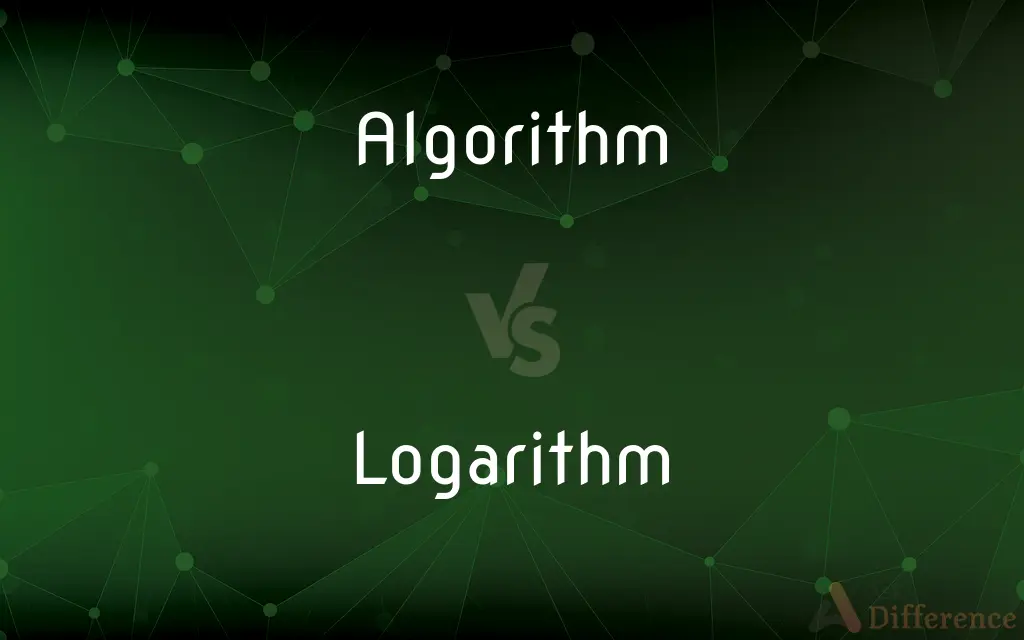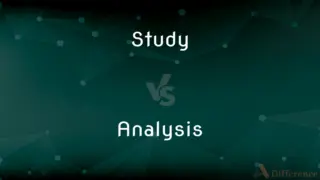Algorithm vs. Logarithm — What's the Difference?
Edited by Tayyaba Rehman — By Urooj Arif — Updated on April 4, 2024
Algorithm is a step-by-step procedure for calculations or problem-solving. Logarithm is a mathematical operation, the inverse of exponentiation.

Difference Between Algorithm and Logarithm
Table of Contents
ADVERTISEMENT
Key Differences
An algorithm refers to a set procedure or formula for solving a problem, often used in computing and mathematical operations. It is a series of instructions that tells how to solve a particular problem step by step. Whereas, a logarithm determines how many times a specific number, called the base, must be multiplied by itself to reach another number. It is a concept from mathematics, particularly exponentiation.
While algorithms can be applied to a wide range of problems, from simple arithmetic to complex computational tasks across various fields, logarithms specifically deal with the relationship between exponents in mathematics. Algorithms can involve any number of steps and methodologies, tailored to the complexity and nature of the problem being addressed. On the other hand, logarithms follow a specific mathematical rule and are used to simplify multiplication and division into addition and subtraction, making complex calculations easier.
Algorithms are foundational to computer science, where they are used to design software, solve data processing tasks, and perform automated reasoning. An algorithm could be as simple as a cooking recipe or as complex as the Google search algorithm. Whereas, logarithms are essential in various fields of science and engineering, particularly where scaling phenomena are studied, such as in acoustics (decibels), earthquake intensity (Richter scale), and in financial models calculating compound interest.
The development of algorithms requires understanding the problem, devising a plan, and creating a step-by-step procedure to achieve the desired outcome. This process is creative and can vary greatly depending on the task at hand. Conversely, understanding and using logarithms require knowledge of exponential functions and their properties, with applications following well-defined mathematical principles.
Algorithms are about the process and steps taken to solve problems, adaptable across various contexts and problems. Logarithms, however, are a mathematical operation used to simplify complex exponential relationships into more manageable forms.
ADVERTISEMENT
Comparison Chart
Definition
Step-by-step procedure for calculations or problem-solving
Mathematical operation, inverse of exponentiation
Application
Broad, across various fields and problems
Specific, in mathematical calculations and scaling phenomena
Nature
Process-oriented, can be simple or complex
Mathematical principle, follows specific rules
Importance
Foundational in computing and automated reasoning
Essential in science, engineering, and finance for simplifying calculations
Example Usage
Designing software, solving data tasks
Simplifying multiplication and division, calculating compound interest
Compare with Definitions
Algorithm
Can be designed for specific or general tasks.
They developed an algorithm to optimize the delivery routes.
Logarithm
The power to which a base, such as 10, must be raised to produce a given number.
The logarithm base 10 of 100 is 2.
Algorithm
A procedure or set of rules followed in calculations or problem-solving.
The algorithm efficiently sorted the list of numbers.
Logarithm
Simplifies complex mathematical operations.
Logarithms convert multiplication into addition, making calculations easier.
Algorithm
Involves creativity and understanding of the problem.
The new encryption algorithm increased data security.
Logarithm
Follows the inverse of exponentiation.
If 10^x = 100, then log_10(100) = x.
Algorithm
Executed through programming in computing.
The search algorithm helps find information quickly on the internet.
Logarithm
Used in scientific and engineering contexts.
Logarithms are essential in calculating sound intensity in decibels.
Algorithm
Continuously improved for efficiency.
Updates to the algorithm significantly reduced processing time.
Logarithm
A specific mathematical operation with defined rules.
Understanding logarithms is crucial for solving exponential equations.
Algorithm
In mathematics and computer science, an algorithm ( (listen)) is a finite sequence of well-defined, computer-implementable instructions, typically to solve a class of specific problems or to perform a computation. Algorithms are always unambiguous and are used as specifications for performing calculations, data processing, automated reasoning, and other tasks.
Logarithm
In mathematics, the logarithm is the inverse function to exponentiation. That means the logarithm of a given number x is the exponent to which another fixed number, the base b, must be raised, to produce that number x.
Algorithm
A finite set of unambiguous instructions that, given some set of initial conditions, can be performed in a prescribed sequence to achieve a certain goal and that has a recognizable set of end conditions.
Logarithm
The power to which a base, such as 10, must be raised to produce a given number. If nx = a, the logarithm of a, with n as the base, is x; symbolically, logn a = x. For example, 103 = 1,000; therefore, log10 1,000 = 3. The kinds most often used are the common logarithm (base 10), the natural logarithm (base e), and the binary logarithm (base 2).
Algorithm
(countable) A collection of ordered steps that solve a mathematical problem. A precise step-by-step plan for a computational procedure that possibly begins with an input value and yields an output value in a finite number of steps.
Logarithm
(mathematics) For a number , the power to which a given base number must be raised in order to obtain . Written . For example, because and because . Category:en:Functions
For a currency which uses denominations of 1, 2, 5, 10, 20, 50, 100, 200, 500, 1000, etc., each jump in the base-10 logarithm from one denomination to the next higher is either 0.3010 or 0.3979.
Algorithm
Calculation with Arabic numerals; algorism.
Logarithm
One of a class of auxiliary numbers, devised by John Napier, of Merchiston, Scotland (1550-1617), to abridge arithmetical calculations, by the use of addition and subtraction in place of multiplication and division.
Algorithm
A precise rule (or set of rules) specifying how to solve some problem; a set of procedures guaranteed to find the solution to a problem.
Logarithm
The exponent required to produce a given number
Algorithm
A precise rule (or set of rules) specifying how to solve some problem
Common Curiosities
What is the main difference between an algorithm and a logarithm?
An algorithm is a process or set of steps for problem-solving, while a logarithm is a mathematical operation, specifically the inverse of exponentiation.
Are algorithms only used in computing?
While crucial in computing, algorithms are also used in mathematical problem-solving, data analysis, and even in everyday processes like cooking recipes.
Can algorithms use logarithms?
Yes, algorithms can incorporate logarithms as part of their steps to solve specific mathematical problems, especially those involving exponential functions.
How do logarithms simplify calculations?
Logarithms allow the transformation of multiplication into addition and division into subtraction, simplifying the calculation of large numbers or complex equations.
What is a logarithmic scale?
A logarithmic scale is a way of displaying numerical data over a very wide range of values in a compact way, using the logarithms of values instead of the actual values.
Are logarithms difficult to learn?
Understanding logarithms requires a grasp of exponents and their properties. With practice, the concept becomes more intuitive.
What makes an algorithm efficient?
Efficiency depends on how quickly and with how little resource consumption an algorithm can solve a problem or perform a task.
Where are logarithms commonly used?
Beyond mathematics, logarithms are used in science, engineering, finance, and anywhere exponential relationships need simplification.
Can anyone create an algorithm?
Yes, with an understanding of the problem and logical thinking, anyone can create a simple algorithm, though more complex problems require specialized knowledge.
What is the significance of the base in a logarithm?
The base of a logarithm determines the number that is repeatedly multiplied to reach another number. Common bases are 10 (common logarithm) and e (natural logarithm).
Do all algorithms produce a single correct answer?
Not always. Some algorithms, especially in areas like machine learning, can produce varying results based on different inputs or training data.
How do you design an algorithm?
Designing an algorithm involves understanding the problem, planning a solution, and outlining a series of logical, step-by-step instructions to achieve the desired outcome.
What role do logarithms play in computer science?
Logarithms are important in computer science for algorithms that deal with data compression, encryption, and in calculating time complexity for certain algorithms.
Can the effectiveness of an algorithm change over time?
Yes, as new methods are developed or as the nature of the problem changes, an algorithm's effectiveness can increase or decrease, necessitating updates or redesigns.
How are algorithms tested for correctness?
Algorithms are tested through debugging and validation processes, often using a variety of test cases to ensure they work as intended.
Share Your Discovery

Previous Comparison
Study vs. Analysis
Next Comparison
Cereal vs. SerialAuthor Spotlight
Written by
Urooj ArifUrooj is a skilled content writer at Ask Difference, known for her exceptional ability to simplify complex topics into engaging and informative content. With a passion for research and a flair for clear, concise writing, she consistently delivers articles that resonate with our diverse audience.
Edited by
Tayyaba RehmanTayyaba Rehman is a distinguished writer, currently serving as a primary contributor to askdifference.com. As a researcher in semantics and etymology, Tayyaba's passion for the complexity of languages and their distinctions has found a perfect home on the platform. Tayyaba delves into the intricacies of language, distinguishing between commonly confused words and phrases, thereby providing clarity for readers worldwide.















































